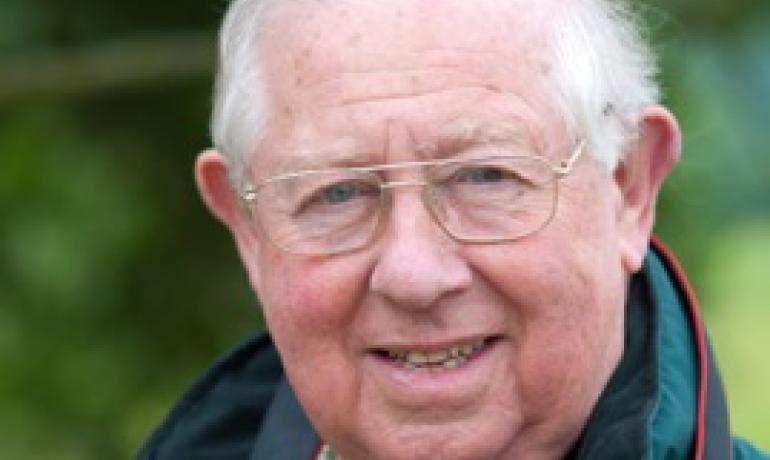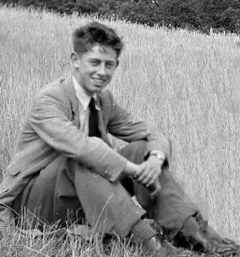Peter O'Loughlin (T50) Shares Some Memories of His Time at Ampleforth

Peter O'Loughlin (T50) kindly shares some memories of his time at Ampleforth from 1940 to 1950 with us:

The following are no more than an unconnected series of anecdotes rather than a
description of Ampleforth life in the 1940s. Of course we did have lessons and games too!
Gilling Castle.
The Incendiary Bomb.
I first came to Gilling aged 8, in September 1940, and I clearly remember being shown the very recently repaired hole in the chapel roof and the charred and scorched floor in the centre of the aisle about six feet inside the door, caused by an incendiary bomb. The photograph of the chapel currently (2017) in the St. Martins Ampleforth website must have been taken from just where the charred floor was. Fortunately two alert monks (I think) dealt with it very expeditiously with the standard long-handled metal shovel and two buckets of sand, ten days before the start of term.
The Three Generators.
While I was lying in the Sick Bay with chicken pox and watching white clouds drifting across the sky, there was a constant thud thud thud from across the courtyard, all day until late evening. Gilling Castle was not yet on the National Grid, and there were three large single cylinder diesel engines in a large room on the ground floor on the opposite side of the courtyard, one was constantly generating power for the whole place until it fell silent, when, I presume, we were running on batteries all night until the thud thud thud started again before breakfast. I understand that one engine would be running, one was on instant stand-by as back up, and the third would be undergoing maintenance or repair. I don’t remember there ever being any problems with the power supply, nor any apparent restriction on its use.
The Low-Flying Aeroplane.
One sunny afternoon several of us were on Temple Hill, looking across the valley when we heard a number of Merlin engines out of sight to the left, in the distance but approaching rapidly. Very soon we found ourselves looking down at a very smart and clean Lancaster bomber, quite close and flying only a few feet above the tallest trees. In retrospect, we were almost certainly seeing one of the Dambusters’ aircraft on a training flight. Even without that knowledge, it was a very impressive sight.
The Junior House.
The Mole-Catcher’s Cottage, Scouts and fireworks.
Since the mole catcher’s cottage hasn’t been there for many years, I should explain that it was an old, small, derelict two story cottage in the valley - stand in front of the Abbey church, and look towards the lakes; go 10 to 15 degrees right and it was about two thirds of the way across the valley. It was the headquarters of the Junior House Scouts. One autumn night we were split into two groups; two thirds of us were to defend the valley buildings - the two cricket pavilions, the bathing pool hut and the scorekeepers’ hut - and the remaining third were given fireworks, two to each person, a slow burning fuse and a small number of matches and told to blow up those buildings, but on no account to put a firework inside them. The fireworks were the usual small tubs which emitted a column of sparks before shooting an explosive ball into the air, like a not-very miniature thunder flash. I was in the group given the fireworks which i put on my head under my beret, producing a rustling sound whenever I moved which convinced me I was being followed, until I realised where the sound was coming from.
It was a very dark night, but just light enough when fully dark-adapted to avoid falling into the Little Holbeck or tripping or trying to walk through a hedge. Some charred corks made our faces, knees and the back of our hands almost invisible. Having been allocated the 2nd. XI pavilion I walked as unobtrusively as possible across the First Fifteen match ground while unable to think of a way of lighting the fuse without everyone in the valley noticing I was striking matches. However the valley seemed completely deserted, so crouching down and trying to look as unlike an arsonist lighting a fuse as I possibly could, I lit the fuse, then took a few steps across the road, put the two fireworks down at the corner of the pavilion, luckily before the two touch-papers ignited the fireworks, and melted back into the night and there was the pavilion, technically destroyed. However another scout did better - he put his fireworks into a dustbin, the lid of which I was told had to be removed from the roof of the First Eleven pavilion the following day. I heard a few days later that my apparent immunity from detection owed nothing to my own skills, as I had indeed been seen lighting the match, but the fireworks’ fuses were mistaken for two cigarettes presumably held by a couple of sixth-formers who would not appreciate having attention drawn to their activities.
The Electric Fence.
Between the Junior House and the playing fields, and more or less in line with the present fence above the Second Eleven pitch, there was a wire fence to keep the cows in. The observant might notice that the wires were not stapled to the posts but passed through insulators. Also there was a little box on one of the posts that went ‘tick’ about every four seconds. However, most of us, myself included, only realised it was a electric fence when we put one wet rugger boot on one of the wires and found ourselves lying on our back in the wet grass looking up at the sky. However, if one was wearing Wellingtons (always rubber in those days) in the wet grass and grasped the wire firmly with both hands there was only a very faint sensation, barely enough to time the impulses, though when making contact just with one’s little finger there would be a faint shock and the finger would jerk slightly. So, on taking a stranger down to the sports fields, and with luck a member of the visiting team, of course one helpfully held the top wire down, though not quite low enough .. and on picking them up from the long wet grass remembered to say in a concerned voice, ‘They must have switched it back on again’.
His Masters’ Voices
We had a cheap but entertaining Ampleforth News, printed on one or two sheets of A4, or foolscap, one feature being a few quotations from the masters. One day Fr Francis Vidal came into one of the classrooms to the left of the entrance hall to find everyone chatting loudly,and none of us noticed his arrival. He banged the desk lid loudly twice and in the startled silence said “If there’s any more noise there’ll be a row”, one of my all-time favourite Masters’ Voices.
The Upper School.
The Blackout.
When I first had lessons in the classrooms overlooking the indoor range, the blackout was still in force, meaning no light was to be visible from outside the building at night. Each of these large windows had a large but light wooden frame covered with blackout cloth, these being put in position where they were not a tight fit and stayed in position by leaning very slightly against the window. We very quickly learned some interesting facts about these blinds, namely that if they were very carefully adjusted to be vertical, sooner or later - and it might take ten minutes or more - they would start to fall into the classroom although it was obvious no one had been near them since the lesson started. Secondly, being so light and with such a large surface area, they started to fall almost imperceptibly, and gathered very little speed as they fell, and finally and crucially, when they landed on one’s head it was a very light blow indeed so one could ignore them falling, and be suitably surprised when they landed. Another Master’s Voice was provided by Count George de Serionne, who tried to teach us French. His French was of course impeccable, but his English, though very good, might perhaps have lacked a full understanding of the nuances and implications of what he was saying, as in this example: “Before I came into this classroom there was no smell. Now there is a very big one. Why?” Although he was quite a tall man, he owned an old small upright Austin 7, and when he was about to drive off we would surround his car to see him go, with several of our stronger boys holding the rear wheels about two inches off the ground. He would go through the gearbox, revving the engine and engaging the clutch, all to no avail, until at the moment he was revving it in top gear it would be dropped onto the ground when it would take off like a startled kangaroo, hop once or twice and stall. A good-natured push-start seemed to be all that was needed to allay his suspicions . . .each time.
‘Benny’ Goodman taught me chemistry. Some of his classes were more memorable than others, if perhaps for the wrong reasons. One day he was to demonstrate the production of ozone by an apparatus that produced a spark when connected to a power supply. At that time we were still on 240 volt 15 amp round pin sockets - 13 amp square pin plugs and sockets were still in the future (from 1947) - and when I was handed a three-pin plug - here the smaller 5 amp version - and told to plug it in, there were two matching sockets one above the other above the bench, so I plugged it into the top one, producing an immediate flash and a bang, a transient smell of ozone and a less transient smell of melting apparatus. I rapidly understood that my intelligence, if any, was infinitesimal, while the ultimate paragon of laboratory assistants, Mr Sarjeson, was summoned, bringing another such apparatus. After it was set up, Sarjeson himself was asked to plug it in. He looked at the plug and put it into the same matching socket, another flash and a bang, more ozone, more melting apparatus. With the third and last apparatus, no one else was to be trusted. Mr Goodman himself . . . yes, you’re right . . . I thought it was most unfortunate that in the ensuing silence I could be heard saying that you wouldn’t think anybody would put two identical unlabelled sockets one above the other, the upper one giving 240 volts A.C. and the lower one 12 volts D.C. However the following week the 12 volt supply had been changed to small two-pin sockets.
Peter O’Loughlin T50.